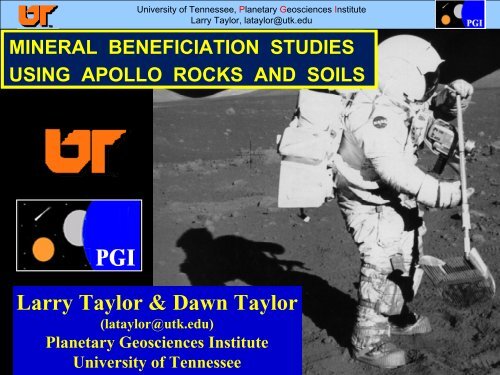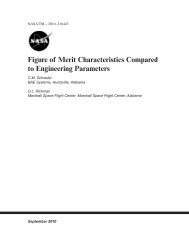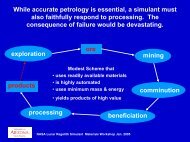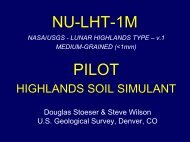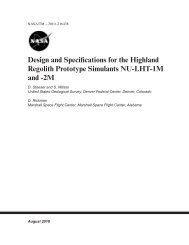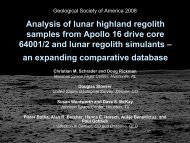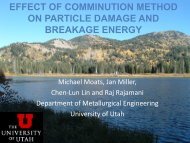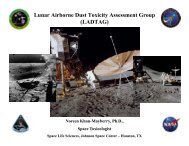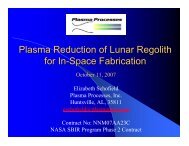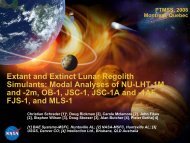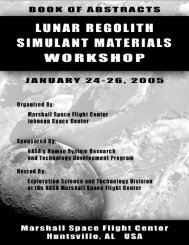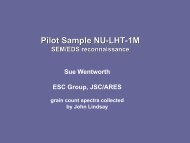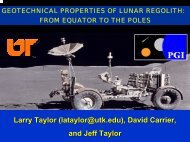Presentation - In Situ Resource Utilization (ISRU)
Presentation - In Situ Resource Utilization (ISRU)
Presentation - In Situ Resource Utilization (ISRU)
You also want an ePaper? Increase the reach of your titles
YUMPU automatically turns print PDFs into web optimized ePapers that Google loves.
University of Tennessee, Planetary Geosciences <strong>In</strong>stituteLarry Taylor, lataylor@utk.edu<strong>ISRU</strong> of the MoonLUNAR SCIENCE IS THE ENTIRE BASIS FOR OURKNOWLEDGE OF LUNAR RESOURCES;Science is the <strong>In</strong>gredient that makes<strong>Resource</strong> <strong>Utilization</strong> of the Moon Possible2
PROCESS FACTORS TO BE CONSIDEREDFOR AN <strong>ISRU</strong> PROCESS• Simplicity of the overall ProcessBatch vs. Continuous Modes• Resupply Massfor reagent Makeup + Attrition of system• Plant Mass and energy Requirements(<strong>In</strong>clude Feedstock Processing)Sensitivity to Production Ratecomparison: Series of Small Self-Contained Modular vsConstructing a Single Large Plant.Effect of solar and Nuclear-Electric Power sources.• Evaluation of FeedstockRocks vs. soils; Maria vs. HighlandsBeneficiated and Unbeneficiated Feedstocksensitivity of Process Mass and Power to Feedstock
Impact-GlassBeadUniversity of Tennessee, Planetary Geosciences <strong>In</strong>stituteLarry Taylor, lataylor@utk.eduLunar Mare SoilVolcanic GlassBeadAgglutinateRockChipsRock FragmentsMineral FragmentsGlassy ParticlesAgglutinatesImpact-Glass DropletsVolcanic Glass SpheresImpactGlassPlagioclase1 mmRegolith: broken up rock material; ‘Soil’:
Lunar Mare SoilUniversity of Tennessee, Planetary Geosciences <strong>In</strong>stituteLarry Taylor, lataylor@utk.edu
100 mUniversity of Tennessee, Planetary Geosciences <strong>In</strong>stituteLarry Taylor, lataylor@utk.eduAgglutinatesIlmeniteVolcanic Glass BeadSEMGasVesiculeAgglutinitic GlassPolishedsection50 mRockletPieces of minerals, rocklets, and glasswelded together by shock-melt glass
Soil Maturation of a Mare SoilVolume %806040Particle %80604020MineralFragmentsBasaltFragmentsAgglutinatesimmature submature mature20 40 60 80I s/ FeOAgglutinatesMineralsImmature Soilis Better forMineralBeneficiation20Basalt FragmentsThanTaylor & McKay (1992)Immature Submature Mature20 40 60 80I s / FeO = MATURITYMature Soil!EXPOSURE AGE
University of Tennessee, Planetary Geosciences <strong>In</strong>stituteLarry Taylor, lataylor@utk.eduLow-Ti Mare SoilsHigh-Ti Mare SoilsTaylor et al. (2001)15071-52 15041-9412030-14 12001-5671501-35 10084-7871061-14 70181-47 79221-81Volume Abundabces in Soil FractionTiO 2= 3.6 1.6 2.8 1.7 7.3 9.5 8.1 7.3 6.5100806040200ImMature20-45 m10-20 m
Lunar Highland Soils Taylor et al. (2010)Apollo 14 Apollo 16Volume Abundabces in Soil FractionMATURITYMATURITYGlass abundances <strong>In</strong>crease as Grain-Size Decreases
University of Tennessee, Planetary Geosciences <strong>In</strong>stituteLarry Taylor, lataylor@utk.eduProduction of LLOX by LLH Reduction of IlmeniterecycleFeTiO 3 + H 2 Fe + TiO 2 + H 2 O electrolysis H 2 + ½ O 2IlmenitefeedSolidProductOxygenProductH 2 most easily breaks the bonds between the Fe and the O!Fe XYO + H 2Fe + XY + H 2 O
Hydrogen Reduction ofIlmenite and Lunar Soil(Gibson & Knudson)LunarRegolithOversizerejectionBeneficationTrailingsUniversity of Tennessee, Planetary Geosciences <strong>In</strong>stituteLarry Taylor, lataylor@utk.eduSurface miningReactorfeedFluidized-bedreactorFeXYO + H 2→Fe + XY + H 2O←Spentsolids→↓LUNOXproductOxygenliquefaction→ElectrolysisMakeupheat←←Oxygengas↓↓PowerH 2<strong>In</strong>putHeatexchanger
University of Tennessee, Planetary Geosciences <strong>In</strong>stituteLarry Taylor, lataylor@utk.eduMagnetic Susceptabilities of Sized Soils andCrushed/Sized RocksCalibirated Frantz Magnetic Separator +Magnetic Susceptability StandardsCollected Susceptability Modes as SplitsParticle Abundances:Polished Grain Mount in EpoxyEMP X-ray Digital ImagingDetails in Oder and Taylor (1990)
University of Tennessee, Planetary Geosciences <strong>In</strong>stituteLarry Taylor, lataylor@utk.eduHi-Ti Apollo 17IMMATURE Soil(Is/FeO = 14)Taylor & Oder (1990)Impact Glass <strong>In</strong>creases with<strong>In</strong>creasing Magnetic SusceptabilityAs a result of Nanophase Metallic Fe!
University of Tennessee, Planetary Geosciences <strong>In</strong>stituteLarry Taylor, lataylor@utk.eduHi-Ti Apollo 17SUBMATURE Soil(Is/FeO = 35)Taylor & Oder (1990)
University of Tennessee, Planetary Geosciences <strong>In</strong>stituteLarry Taylor, lataylor@utk.eduHi-Ti Apollo 11MATURE Soil(Is/FeO = 76)Taylor & Oder (1990)LOHI
University of Tennessee, Planetary Geosciences <strong>In</strong>stituteLarry Taylor, lataylor@utk.eduTaylor & Oder (1990)Highland Apollo16MATURE Soil
Some Conclusions from Mare Soil studyIlmenite Concentrates in <strong>In</strong>termediate Magnetic Susceptibilities of60-160 m cc/gm; this is in distinct contrast to terrestrial ilmenite;Ilmenite Abundance Decreases as Maturity <strong>In</strong>creases.Best Soil for Ilmenite Recovery = Immature Hi-Ti Mare Soil.Major Portion of Ilmenite is in Coarse-Grained Basalts Fragments<strong>In</strong> the >74 micron Fractions; Grinding of the >74 micron Soil isNecessary to Liberate these IlmenitesAlthough ~50% of the Ilmenite in a Hi-Ti Soil can be Recovered byMagnetic Separation, it may be difficult to “high-grade”;Estimated that about 0.1 lb. of Ilmenite of an Immature Hi-Ti Mare soilCan be Recovered per Pound of Soil.
MAGNETOGRAMS71055 Rock71061Immature Soil10058 Rock10084Mature SoilTaylor & Oder (1990)
University of Tennessee, Planetary Geosciences <strong>In</strong>stituteLarry Taylor, lataylor@utk.eduApollo 11 + 17FeTiO 3100 m19
University of Tennessee, Planetary Geosciences <strong>In</strong>stituteLarry Taylor, lataylor@utk.eduApollo 15 Mare Basalt0.2 mm
University of Tennessee, Planetary Geosciences <strong>In</strong>stituteLarry Taylor, lataylor@utk.eduApollo 17 High-Ti Basalt (transmitted light)PyroxeneOpaque MinsOlivinePlagioclase0.4 mm70017, 4
University of Tennessee, Planetary Geosciences <strong>In</strong>stituteLarry Taylor, lataylor@utk.eduApollo 17 High-Ti Basalt (reflected light)Ilmenite FeTiO 3 70017, 4Armalcolite(FeMg)Ti 2 O 50.4 mmChromiteFeCr 2 O 4Ulvöspinel Fe 2 TiO 4
University of Tennessee, Planetary Geosciences <strong>In</strong>stituteLarry Taylor, lataylor@utk.eduApollo 11 RockMedium-GrainedHi-Ti Mare BasaltCRUSHED
University of Tennessee, Planetary Geosciences <strong>In</strong>stituteLarry Taylor, lataylor@utk.eduApollo 17 RockFine-GrainedHi-Ti Mare BasaltCRUSHED
University of Tennessee, Planetary Geosciences <strong>In</strong>stituteLarry Taylor, lataylor@utk.eduilmenitePx + OlPlagioclaseCRUSHED ROCK
100University of Tennessee, Planetary Geosciences <strong>In</strong>stituteLarry Taylor, lataylor@utk.eduMINERAL LIBERATIONComposite Mineral Liberation Graph80Cumulativemineral %curvepercent604020Mineral association barsParticle %bars00-10 20-30 40-50 60-70 80-9010-20 30-40 50-60 70-80 90-100Blue Mineral Vol %
University of Tennessee, Planetary Geosciences <strong>In</strong>stituteLarry Taylor, lataylor@utk.eduLiberation StudiesIlmenite Liberation for the 45 – 90 m m SizeFraction of Hi–Ti Basalt 71055Only 50 vol %Ilmenite isClean(80- 100%Liberated)Chambers et al., 1994
University of Tennessee, Planetary Geosciences <strong>In</strong>stituteLarry Taylor, lataylor@utk.eduImmature / Submature High-Ti SoilPROS:• Soils are Already partially Beneficiated (= less handlingthan with rocks);• Locations of High-Ti soils are Well Known, BUT not theabundances of Immature + Submature Soils;. Small Equipment Masses and Low Energy Requirements• Easy Haulage, Simple Sizing + Magnetic / ElectrostaticBeneficiationCONS:• Lower Grade Feedstock than from Rocks;• Lower Yields of Feedstock than from Rocks;• Agglutinate / Impact Products complicate Beneficiation;• Immature / Submature Soils not as Abundant as Mature;• Immature / Submature Soil Locations Largely Unknown.
University of Tennessee, Planetary Geosciences <strong>In</strong>stituteLarry Taylor, lataylor@utk.eduCourse-Grained High-Ti BasaltsPROS:• Higher Grade Feedstock than from Soils;• Higher Yields of Feedstocks than from Soils;• Lack of Weathering Products Simplifies BeneficiationCONS• Locations of Specific Rock Types Poorly Known(No Outcrops samples by Apollo Missions);• Extensive Processing Required; Blasting, Grizzly,Crushing, Long Haulage;• Large Equipment Masses (Crushing, Grizzly, Haulers)& Large Energy Requirements for Mining andBeneficiation.
University of Tennessee, Planetary Geosciences <strong>In</strong>stituteLarry Taylor, lataylor@utk.eduWith Benefication of Lunar Soils by1)Sizing2)Magnetic separationThe Production of Ilmenite Feedstock isBetter for High-Ti Rocks (Taylor et al, 1992)Than for High Ti Soils (Taylor and Order, 1990),But by less than a Factor of Two
University of Tennessee, Planetary Geosciences <strong>In</strong>stituteLarry Taylor, lataylor@utk.eduConclusionMost Feasible Production ofIlmenite-Rich Feedstock:Magnetic / Electrostatic Beneficiationof the20 Micron Fraction ofImmature / submature High-Ti Soil
University of Tennessee, Planetary Geosciences <strong>In</strong>stituteLarry Taylor, lataylor@utk.eduLunar minerals of both mare soils and basalts were effectivelyconcentrated by magnetic separation; Grades High; Yields Low!Where are ilmenite concentrations in the regolith the highest?Prime locations for oxygen production from ilmeniteHigh concentrations of 3He, hydrogenLocation of immature regolith specially suited for resource extraction?Less glass may mean easier extraction of oxygen from ilmenite.Crushed Rock Fragments are easier to magnetically separate thanSoil Particles;Even though higher grade mineral feedstocks can be obtained byMagnetic Beneficiation of rocks, the increased cost of crushing andgrinding may make soils the more feasible raw material.32
University of Tennessee, Planetary Geosciences <strong>In</strong>stituteLarry Taylor, lataylor@utk.edu
University of Tennessee, Planetary Geosciences <strong>In</strong>stituteLarry Taylor, lataylor@utk.eduA “Watery” Lunar SurfaceThree (3) Different Origins for water on the MoonTwo (2) that are EXogenic (external)One (1) that is ENDogenic (internal)


